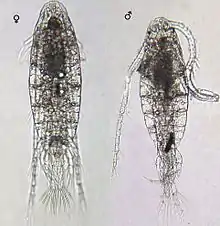Leptodiaptomus ashlandi
Leptodiaptomus ashlandi is a calanoid copepod zooplankton native to the Laurentian Great Lakes and their basin.
| Leptodiaptomus ashlandi | |
|---|---|
 | |
| Female and male L. ashlandi | |
| Scientific classification | |
| Kingdom: | Animalia |
| Phylum: | Arthropoda |
| Subphylum: | Crustacea |
| Class: | Hexanauplia |
| Order: | Calanoida |
| Family: | Diaptomidae |
| Genus: | Leptodiaptomus |
| Species: | L. ashlandi |
| Binomial name | |
| Leptodiaptomus ashlandi (Marsh, 1893) | |
Distribution
Leptodiaptomus ashlandi is a zooplankton species widely distributed across Canada and the northern half of the United States in large deep lakes. It occurs in all the Great Lakes.[1]
Morphology
Adult females of L. ashlandi can be distinguished by their two-segmented urosome and asymmetrical, rounded metasomal wings. Males are characterized by a large lateral spine on leg 5, located in the proximal third of the terminal segment, and by the presence of a slender process on the third segment from the distal end of the right antennule.[2] This species is morphologically similar to other leptodiaptomids (Leptodiaptomus minutus, L. sicilis) and skistodiaptomids (Skistodiaptomus oregonensis).
Ecology
Leptodiaptomus ashlandi are known prey items for a number of native and non-native Great Lakes fishes. They are also prey items for other invertebrate zooplankton. Remains have been found within gut-contents of Mysis diluviana[3] and are trophically below Limnocalanus macrurus.[4]
References
- Mary D. Balcer, Nancy L. Korda & Stanley I. Dodson (1984). "Life history and ecology of the major crustacean species". Zooplankton of the Great Lakes: a guide to the identification and ecology of the common crustacean species. University of Wisconsin Press. pp. 49–109. ISBN 978-0-299-09820-9.
- Hudson, Patrick L., and Lynn T. Lesko. 2003. Free-living and Parasitic Copepods of the Laurentian Great Lakes: Keys and Details on Individual Species. Ann Arbor, MI: Great Lakes Science Center Home Page. http://www.glsc.usgs.gov/greatlakescopepods/MainMenu.php?
- Brian P. O'Malley, David B. Bunnell. 2014. Diet of Mysis diluviana reveals seasonal patterns of omnivory and consumption of invasive species in offshore Lake Michigan, Journal of Plankton Research, Volume 36, Issue 4, July/August 2014, Pages 989–1002, https://doi.org/10.1093/plankt/fbu038
- Doubek, J. P., & Lehman, J. T. (2014). Historical trophic position of Limnocalanus macrurus in lake Michigan. Journal of Great Lakes Research, 40(4), 1027-1032.